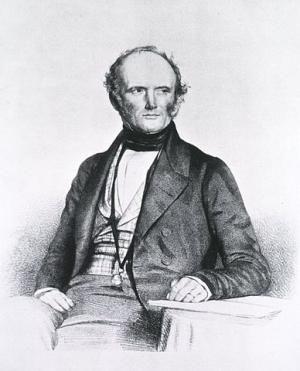
In part 1, I discussed a passage attributed to Charles Lyell by Luther Tracy Townsend, whose Collapse of Evolution (1905), as Ronald L. Numbers notes in The Creationists (1992), “assembled one of the earliest—and most frequently cribbed—lists in order to prove that ‘the most thorough scholars, the world’s ablest philosophers and scientists, with few exceptions, are not supporters, but assailants of evolution.’” According to Townsend, Lyell wrote, “In the year 1806 the French Institute enumerated not less than eighty geological theories which were hostile to the Scriptures; but not one of those theories is held to-day.” The passage appears not anywhere in Lyell’s work, however, but instead (more or less) in Albert Barnes’s The Progress and Tendencies of Science (1840). So how did Townsend form the idea that it was from Lyell?
Well, at the end of Barnes’s paragraph, there’s a footnote: “Comp. Lyell’s Geology, vol. ii, pp. 156, 157. Edit Phil. 1837.” It’s clear, however, that Barnes is citing Lyell in the service not of the claim that in the long run geology tends to confirm the Bible, but in the service of showing a “remarkable” fact, namely, “Amidst all on which the geologist relies to demonstrate the existence of animals prior to the Mosaic account of the creation, he has not presented us with one human bone, or with one indication of the existence of man” (emphasis in original). And the citation to Lyell is to a passage in which Lyell is discussing George Berkeley’s argument in Alciphron (1732) that if humans were ancient, evidence in the form of ancient human artifacts would be available. (This is the very same argument that I discussed in “The Dating of the Cherry” part 1 and part 2.)
Barnes fails to note, by the way, that Lyell was skeptical of Berkeley’s argument. He concedes to Berkeley that “[t]he earth’s crust must be remodeled more than once before all the memorials of man which are continually become entombed in the rocks now forming will be destroyed. One complete revolution will be inadequate to efface every monument of our existence” (emphasis in original). (By the way, Alan Weisman’s The World Without Us [2007] is a fascinating investigation of the processes that Lyell sketches, taking account of post-Victorian innovations such as plastic.) But Lyell insists, “Yet it is no less true, as a late distinguished philosopher has declared, ‘that none of the works of a mortal being can be eternal.’” (The late philosopher was Humphry Davy, quoted from Consolations in Travel [1830], if you were curious.)
It’s also worth noticing that Lyell is skeptical of the attitude that Barnes and Townsend share. In A Second Visit to the United States of North America—a work that I have to admit to not having so much as skimmed before—Lyell devotes a few paragraphs, in a chapter describing his travels from Cincinnati to “Pittsburg” (sic) and the paleontological investigations he pursued along the way, to considering “Prejudices opposed to the Reception of Geological Truths”:
I cannot conclude these remarks on the geological discoveries made in these remote valleys of the Alleghanies [sic], without alluding to a moral phenomenon, which was forcibly brought before my mind in the course of the investigation. The interest excited by these singular monuments of the olden times, naturally led to animated discussions, both in lecture-rooms and in the columns of the daily journals, of Pennsylvania, during which the high antiquity of the earth, and the doctrine of former changes in the species of animals and plants inhabiting this planet before the creation of man, were assumed as established truths. But these views were so new and startling, and so opposed to popular prepossessions, that they drew down much obloquy upon their promulgators, who incurred the censures not only of the multitude, but also of some of the Roman Catholic and Lutheran clergy. The social persecution was even carried so far as to injure professionally the practice of some medical men, who had given publicity to the obnoxious doctrines. Several of the ministers of the Lutheran church, who had studied for years in German universities, were too well informed not to believe in the conclusions established by geologists, respecting the immensity of past time and former vicissitudes, both in animal and vegetable life; but although taking a lively interest in discoveries made at their own door, and joining in the investigations, they were compelled by prudence to conceal their opinions from their congregations, or they would have lost all influence over them, and might perhaps have seen their churches deserted. Yet by maintaining silence in deference to the opinions of the most ignorance, they become, in some degree, the instruments of countenancing error; nay, they are rearing up the rising generation to be, in their turn, the persecutors of many of their contemporaries, who may hereafter be far in advance in their scientific knowledge.
Dismayed by the situation in Pennsylvania, Lyell recommends a method for obtaining the liberty to discuss the results of scientific inquiry: “by educating the millions, and by dispelling their ignorance, prejudices, and bigotry.” Establish free schools and “raise the qualifications, pay, and station in society” of the teachers, he recommends, “and the persecution I have complained of will cease at once and for ever.” (Well, it’s worth a shot, right?) But there’s a loose end here, which I will try to address in part 3.

